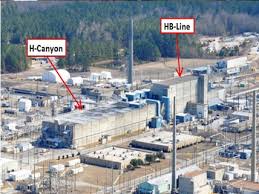
Looks like personnel at the aging H-Canyon reprocessing plant can’t even hang a warning sign correctly. If they don’t sweat the small stuff what about the big stuff?
The Defense Nuclear Facilities Safety Board ( NFSB) reports that a sign placed above the degraded H-Canyon exhaust tunnel, through which radioactive discharge is vented, was falling down. The purpose of the sign was to make sure that heavy vehicles did not drive over the tunnel. The DNFSB reports:
“As a result of concerns raised by the resident inspector (RI) regarding the static capacity of the H-Canyon Exhaust Tunnel, H-Canyon personnel have limited the traffic over the tunnel to vehicles with two or fewer axels (see 7/14/17 report). H-Canyon personnel placed a barricade with a sign stating the limit on the roadways traversing the tunnel. Last week the RI walked down Outside Facilities and noted that the sign on a barricade had partially fallen. Additionally, the barricade was turned 90 degrees from the intended direction such that a vehicle approaching the tunnel would not be able to read the sign. The RI passed these observations to facility personnel. The barricade has since been placed correctly and the sign reattached. H-Canyon personnel are planning to replace the barricades with permanent and painted signs on the road.”
Note: SRS Watch gladly offers to provide hammers, nails, wooden or steel posts, bolts, drills and paint if needed.
Additionally, looks like some non-Aluminum clad spent fuel storage containers in the L-Basin may be corroded, given release of gas bubbles caused by chemical reactions:
“In addition to aluminum-clad spent nuclear fuel (SNF), L-Basin has a smaller inventory of zirconium alloy and stainless steel clad SNF. Much of this SNF consists of uranium metal fuel. If the uranium metal fuel comes in direct contact with water, it can react and form uranium oxide and release hydrogen gas. Much of this fuel was cut into pieces and the cladding sometimes ruptured during irradiation. (See DNFSB Technical Report-38). This week, SRNS conducted underwater inspections of five containers containing this non-Al-clad SNF that was stored underwater in L-bundles or aluminum tubes. One potential concern is the possibility of galvanic corrosion where the zirconium or stainless steel is in direct contact with aluminum (i.e., corrosion from the inside out). The RI observed the inspection of two of these items. The visual inspections of the exterior of the outer container did not identify any areas of significant corrosion although there are some darker areas and nodules that are of interest. In addition, when the L-bundle containing several cans (approximately 55 years old) was handled, a burst of gas bubbles emerged from the openings at the top of the L-bundle. This could indicate that some of the can seals have failed and water is reacting with the uranium metal fuel. Additional bubbles emerged when an aluminum tube containing a can of high burnup fuel was handled. If plans to perform ultrasonic testing come to fruition, that might be able to detect any thinning of the containers due to corrosion or accumulation of corrosion products at the bottom of a container.”
Why isn’t dry storage of this potenitally problematic fuel being aggressively pursued?
DNFSB meeting report for March 19, 2021: https://www.dnfsb.gov/sites/default/files/document/23141/Savannah%20River%20Week%20Ending%20March%2019%202021.pdf